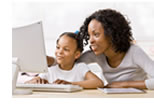What “universal” language promotes reading, creativity, and comprehension skills all at the same time? MUSIC!
According to neurobiologist Norman M. Weinberger, music exists in every culture. Parents all over the world sing to their babies. Music provides us with a natural and rhythmic way to learn. Do you ever wonder why children learn to sing their ABCs before they can say them? Do you notice that so many of our favorite children’s books have a certain rhyme or rhythmic pattern? Many studies show that there is a very strong connection between literacy and music. Through music, children learn to:
· Understand language (we must comprehend language in order to become “true” readers)
· Experiment with rhythm, words, tempo, and melody (which are important skills in reading aloud)
· Think creatively and holistically
· Make the connection between print and spoken words
· Practice motor development and motor coordination while experimenting with various instruments and dancing
· LISTEN (we sometimes forget that listening is an important literacy skill)
Does this mean that we pipe classical music into the background all day and expect preschoolers and kindergarten children to miraculously begin reading at a third grade reading level? Of course not! Here are some more reasonable and practical ways to assimilate music into the lives of young children:
1. Expose children to a variety of music from a young age. Different music has different tempos and rhythms so exposure to all genres of music, according to some experts, helps brain development.
2. Do not use music as background “filler” all the time. I have been in classrooms where music is playing non-stop. Sometimes it’s ok to just let children hear their own chatter and their own thoughts! Besides, you don’t want children to become immune to the music as background “noise.” You want music to catch their attention rather than just be part of the background!
3. Recognize the effect music has on children’s behavior. Classical music or jazz played at the right time of day can have a calming effect.
4. When introducing a new song or poem to children, write it down on chart paper. This helps children make the connection between written and spoken language.
5. Don’t rely only on recorded music. Sing to your children. Recite poems and finger plays. These activities should be a part of children’s daily routine.
6. Provide children with a variety of instruments. While children should have time to experiment with instruments on their own, the teacher should also provide structured time where children learn to play their instruments to a certain rhythm or they can echo a rhythm played by the teacher.
7. When listening to music, encourage children to listen and try to identify various instruments that they hear.
8. If you have parents that play an instrument, invite them into your classroom to show the children.
9. Contact your local symphony to see if they have a free or low-cost outreach programs. If not, check with your local college or high school! The members of the band may be able to visit your childcare center or school!
10. Hum a song and let the children guess what it is! This seems like a simple activity but it really encourages listening, thinking, and problem solving.
11. DANCE! Some children are kinesthetic learners and movement is important to these students!
I have a ton of favorite children’s songs – too many to list here. But some of my favorite children’s musicians are
·
Putumayo Kids (This series has a great collection of world music.)
Here are some books that may inspire the musicians in your class:
Other Musical Resources:
Check your local symphony to see if their website has a link for teachers or children. For example, The Dallas Symphony Orchestra has the DSO Kids Club and The Baltimore Symphony Orchestra has a link for BSO Kids
Written by Tonya Wright




